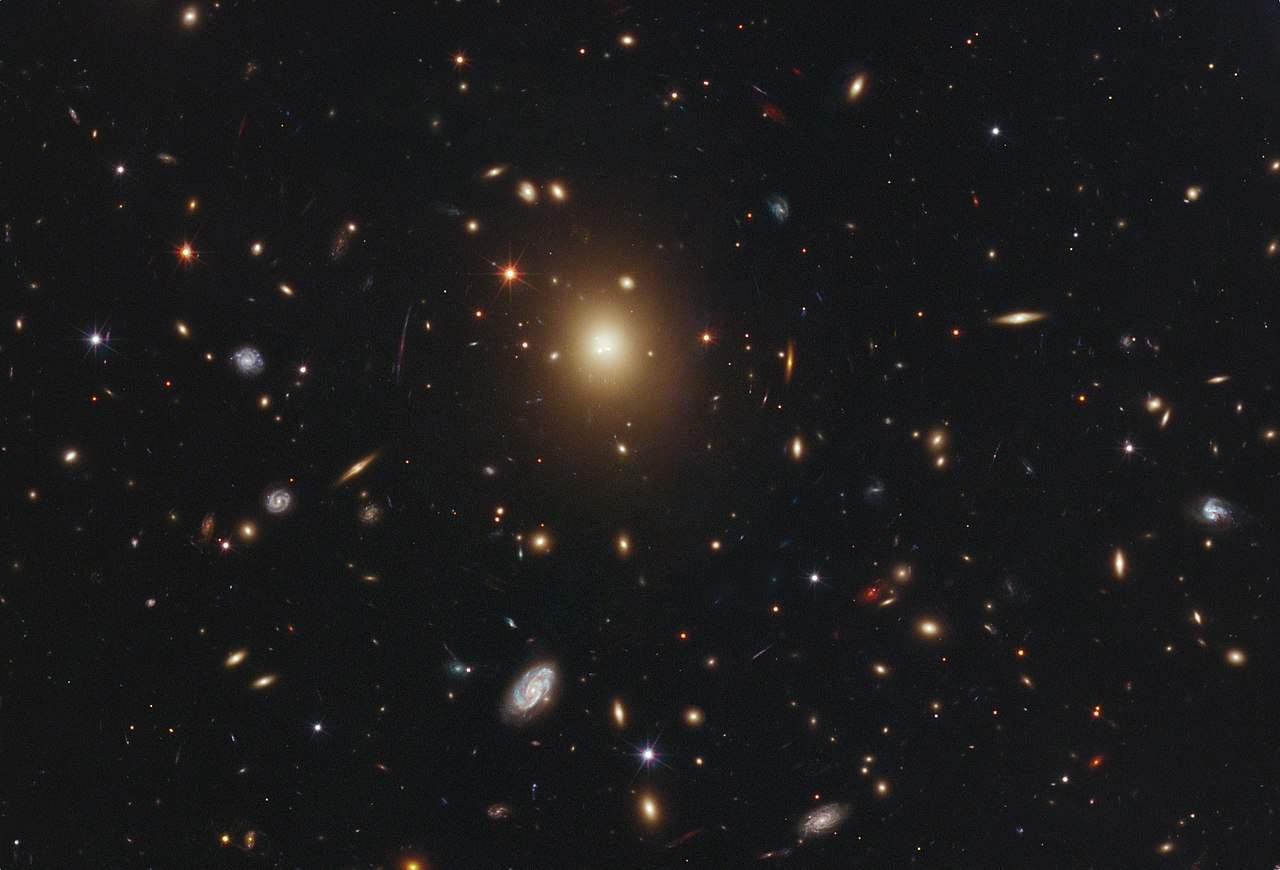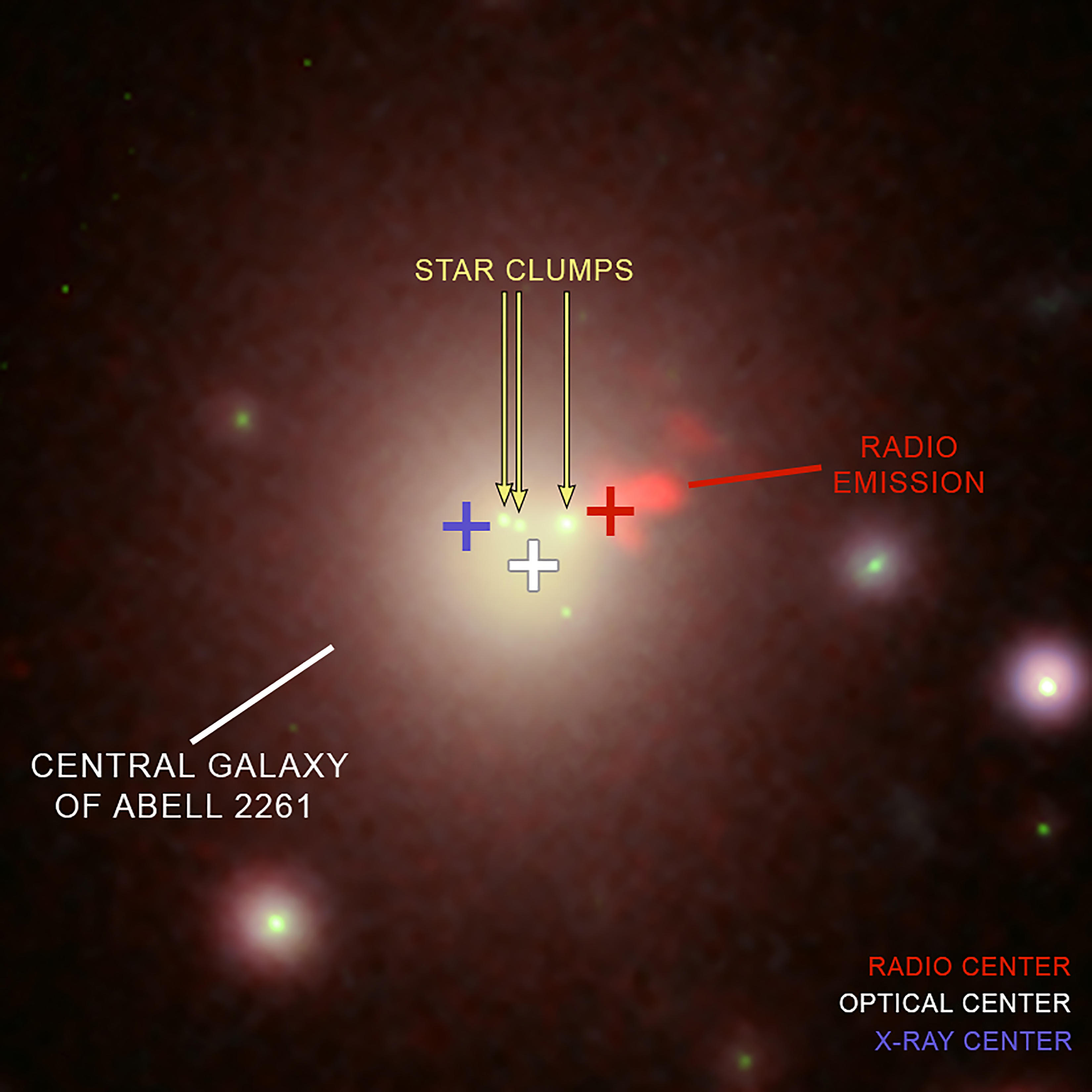There is no trace of a black hole with a mass of 10 billion times the sun. What has it encountered?
The Translation Bureau is a translation team of 36Kr. It focuses on science and technology, business, workplace, life and other fields, and focuses on introducing new foreign technologies, new perspectives, and new trends.
Editor’s note: There are many supermassive black holes in the universe, and they have been carrying out their own gluttonous feast: devouring the surrounding celestial bodies. In this process, dazzling accretion disks and powerful jets will form around the black hole, which are important clues for people to observe the black hole. However, the emergence of the giant galaxy cluster Abell 2261 has caused scientists to encounter Waterloo for black hole research. This article is translated with permission from The New York Times, author Dennis Overbye, original title Missing: One Black Hole With 10 Billion Solar Masses.
The galaxy cluster Abell 2261 (middle left) taken by the Hubble Space Telescope. Its diameter is about 1 million light-years, which is 10 times the diameter of the Milky Way. Picture from “New York Times”
Astronomers believe that there is a supermassive black hole hidden in the center of almost every large galaxy in the universe, whose mass is millions or billions of times that of the sun. The larger the galaxy, the larger the black hole at its center.
Because the mass of the central black hole is usually the same as the mass of the galaxy itself, ten years ago, Marc Postman of the Space Telescope Science Institute used the Hubble Space Telescope to survey the galaxy People were surprised to find that there was no shadow of a black hole in the center of a super-giant galaxy. Under normal circumstances, due to the powerful gravitational force of the giant black hole, the scattered stars and planets are adsorbed into individual galaxies. This is why the center of the galaxy is shining.
However, the core of this huge galaxy, which should have been a little bit of starlight, actually has nothing. Moreover, a cloud of stars with a diameter of about 20,000 light-years should be the center of the galaxy, but it is not in its position.
Tod Lauer is an American galactic nuclear expert. When he recalled the news that Mark sent him, he still couldn’t help but sigh: “Oh my God, this is really unusual.”
For the next few years, the two researchers and their colleagues have been searching for the X-rays or radio waves that are produced when falling into a black hole.
This disappearing black hole is located in a huge galaxy in the center of the galaxy cluster Abell 2261 (official name: A2261-BCG). The galaxy is about 2.7 billion light-years away from the earth and is located in the constellation Hercules in the northern sky, not far from Vega. According to experience, the estimated mass of this black hole is at least 10 billion times that of the sun, and its mass is comparable to the mass of some of the largest known black holes in the universe. You know, the black hole in the center of the Milky Way is only about 4 million times the mass of the sun.
So, where does nature hide this “Big Mac”?
There are now two speculations: one possibility is that the black hole exists, but the speed of swallowing matter is too slow to produce a detectable X-ray signal; the other possibility is that the disappearing black hole is completely destroyed “Bounce” out of the center of the host galaxy.
Each peach has a core
Proving the second possibility can help people understand the violent evolution of galaxies and the universe. But cosmologists only speculate on this possibility, and there is no direct evidence to prove that this event actually happened.
Mark wrote in an email: “We have been trying to unravel this mystery. The upcoming James Webb Space Telescope that is about to launch may hopefully help us.”
“What happens when a supermassive black hole is ejected from a galaxy?” Dr. Lauer asked.
Raul is a member of an informal group calling himself “Nukers.” This group was born almost at the same time as the Hubble Telescope and was developed by Sandra Faber of the University of California, Santa Cruz. In the past four decades, they have tried to use the Hubble Telescope and other astronomical instruments to clarify the nature of galaxy nuclei and to explore the centers of distant galaxies.
Laure said: “A2261-BCG will tell us a story about the evolution of the largest galaxy in the universe.”
Radio signals detected near the center of the Milky Way galaxy indicate that supermassive black hole activity occurred there 50 million years ago. imageFrom The New York Times
Black holes are extremely dense objects, and even light cannot escape their gravitational “claws”. By definition, people cannot see them with the naked eye. But because black holes produce high-speed jets and X-rays when they swallow objects, these wavebands can be detected. In the 1960s, astronomers discovered quasars in the core of the galaxy, 430 trillion times brighter than the sun. Astronomers believe that this is because the supermassive black hole is attracting surrounding matter. These matter collide with each other and release huge energy around the black hole. Therefore, a huge light is generated.
At the beginning of this century, astronomers concluded that there is a supermassive black hole hidden in the center of every galaxy, the mass of which is several million to several billion times that of the sun. But where did these black holes come from? Some people speculate that when a star collapses, a black hole with a large mass and a small volume will be formed. It is also believed that as early as the beginning of the universe, black holes were formed through other means. No one can give an accurate answer.
How do black holes affect the surrounding environment?
In 1980, three astronomers Mitchell Begelman, Martin Rees and Roger Blandford published a A report on the influence of the evolution of the galaxy. They proposed that two galaxies collide and merge to form a new galaxy, and the central black hole in each galaxy merges to form a huge black hole. In each galaxy, the supermassive black hole sinks into the center of the newly merged galaxy during the merger.
Mitchell and his colleagues believe that these two huge black holes are bound to each other under the action of gravity, and their orbits begin to shrink. Then, the black hole interacts with the surrounding stars, and the gravitational force of the black hole pushes the star away from the center, making the connection between the two black holes closer.
As time goes by, more and more stars will be “thrown” out of the center of the galaxy. Gradually, the stars once concentrated in the center of the galaxy spread farther and farther, forming a gleaming vortex. At the center of this vortex, there is a small black hole, where is the “dwelling place” of the two merged black holes.
When Raul talked about these three great astronomers, he said: “They are at the forefront of the times.”
A tricky question
Mark and Raul believe that black hole mergers occurred in Abell 2261. However, there is no peak in the center of the galaxy cluster, and the supermassive black hole and its surrounding stars seem to have disappeared out of thin air.
This raises the more dramatic possibility that the merger of black holes has already happened. When black holes merge, gravitational waves are produced (in 1916, Einstein first proposed the gravitational wave hypothesis). A hundred years later, the United StatesThe Laser Interference Gravitational Wave Observatory (LIGO) finally detected the existence of gravitational waves.
The theory predicts that when black holes merge, they will produce ripples of gravitational waves in space and time. The waves emitted from all directions are not uniform. If a large number of gravitational waves are produced in one direction that is significantly stronger than the other, a new large black hole may be ejected from the center of the galaxy. This is called a recoil black hole.
After further observation of A2261-BCG, four eccentric star clusters were found in the galaxy. So, is there a black hole hidden in one of the star clusters?
A team led by Sarah Burke-Spolaor of West Virginia University in the United States used Hubble and the Very Large Array Radio Telescope (VLA) to observe four clusters of stars, and We studied whether the motion of the stars in these star clusters is high enough that they suggest a black hole with a mass of tens of billions of suns.
However, they did not reach a satisfactory conclusion: no obvious black hole evidence was found in two of the star clusters, and there was a huge error in the measurement of the third star cluster, and it could not be ruled out.
As for the fourth star cluster, the internal motion is so weak that scientists cannot draw valid conclusions from it. Sarah said: “We need to use the Hubble Space Telescope to observe this cluster of stars for hundreds of hours.” However, it is still a candidate for the hiding place of the missing black hole.
The cores of galaxies also emit radio waves, but they are not helpful for research.
“We originally hoped that radio waves could provide us with some kind of signal that would allow us to spot an active jet that points directly to the location of the black hole,” Sarah said. But radio emissions detected near the center of the galaxy indicate that the last sign of a supermassive black hole active at the center of the galaxy appeared 50 million years ago. This means that since the jet disappears, the giant black hole has enough time to move to other places.
After failing to use the Hubble Telescope, people turned to NASA’s Chandra X-ray Observatory. The researchers pointed the telescope at the core of the Abell 2261 star cluster and the suspicious clusters of stars. Again, there are no new discoveries. Researchers have shown that if the black hole is assumed to exist, it must swallow the surrounding objects at a speed of one part per million.
At the same time, Imran Nasim of the University of Surrey in the UK published a detailed report analyzing how the merger of two supermassive black holes will transform the Milky Way into what people see now appearance.
Imran said: “In simple terms, the recoil of gravitational waves will kick the supermassive black hole out of the galaxy.” After losing the huge gravitational force of the black hole, the distribution of the surrounding stellar cloud becomes more diffuse. The center of the cluster is the densest place in the entire giant planetary system, but only near the Milky WayOne-tenth the density of stars.
All of the above are reasons why astronomers are eagerly awaiting the launch of the James Webb Space Telescope. It is the “successor” of the Hubble Telescope and is tentatively scheduled to launch at the end of October this year. Once launched, the James Webb Space Telescope can reveal whether there is a supermassive black hole in the center of the Milky Way galaxy or one of the star clusters.
Translator: Soleil

